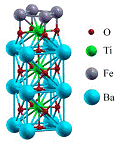Department of Physics and Astronomy: Publications and Other Research

Evgeny Tsymbal Publications
ORCID IDs
Tsymbal http://orcid.org/0000-0002-6728-5523
Document Type
Article
Date of this Version
2010
Citation
Physical Review B (2010) 82: 094114
doi: 10.1103/PhysRevB.82.094114
Abstract
Based on first-principles and model calculations we investigate the effect of polar interfaces on the ferroelectric stability of thin-film ferroelectrics. As a representative model, we consider a TiO2 -terminated BaTiO3 film with LaO monolayers at the two interfaces that serve as doping layers. We find that the polar interfaces create an intrinsic electric field that is screened by the electron charge leaking into the BaTiO3 layer. The amount of the leaking charge is controlled by the boundary conditions which are different for three heterostructures considered, namely, vacuum/LaO/BaTiO3 /LaO, LaO/BaTiO3 , and SrRuO3 /LaO/BaTiO3 /LaO. The intrinsic electric field forces ionic displacements in BaTiO3 to produce the electric polarization directed into the interior of the BaTiO3 layer. This creates a ferroelectric dead layer near the interfaces that is nonswitchable and thus detrimental to ferroelectricity. Our first-principles and model calculations demonstrate that the effect is stronger for a larger effective ionic charge at the interface and longer screening length due to a stronger intrinsic electric field that penetrates deeper into the ferroelectric. The predicted mechanism for a ferroelectric dead layer at the interface controls the critical thickness for ferroelectricity in systems with polar interfaces.


Comments
Copyright © 2010, American Physical Society. Used by permission